Australia So Much to See
Lyndhurst to Leigh Creek and Copley - towns that have lost an industry
The Aboriginal people traded ochre from Lyndhurst and other nearby quarries within the Lake Eyre region for items such a pituri (native
tobacco), spinifex resin, and stone axe heads. The trade in ochre still continues.
Ochre is used as body pain during
ceremonies. Ceremonial use of ochre involves ceremonies not viewed by women or uninitiated men. Women also have ceremonies
involving the use of ochre for body pain. Women only view these ceremonies.
Ochre is often mixed with animal fat and applied
to wooden tools such as shields and boomerangs, to preserve and empower the weapon during use.
Some Aboriginal groups use ochre
for medicinal purposes. Ochre is applied directly onto the ailment or swallowed.
Ochre is used to paint images that
often have symbolic meaning. It is applied dry, or mixed with animal fat or bird eggs to bind the pigments together.
Ochre
is used for burial purposes, and is either applied directly onto the body or scattered over the body during the burial process.
From signage on site, by the Department of State Aboriginal Affairs, Government of South Australia.
A solar power farm is being constructed around ten kilometres north east of Port Augusta. This is planned to be the largest
polycrystalline solar panel power plant in Australia.
The Lincoln Gap wind farm is on hills to the south west of Port
Augusta, with 59 turbines when all are constructed.
Other renewable energy sources are being constructed to replace
the coal-fired power stations, but not where it will give employment to residents of Leigh Creek and Copley.
Five kilometres north of Lyndhurst, we re-visited the Ochre Pits. This large pit has red and yellow ochre. Ochre is a
natural pigment in clay, and comes in a number of earthy colours. Red ochre takes its reddish colour from the mineral hematite
(Fe2O3), which is an anhydrous iron oxide. Yellow ochre is limonite (FeO·nH2O) but the formula can vary according to the ratio
of oxide to hydroxide.
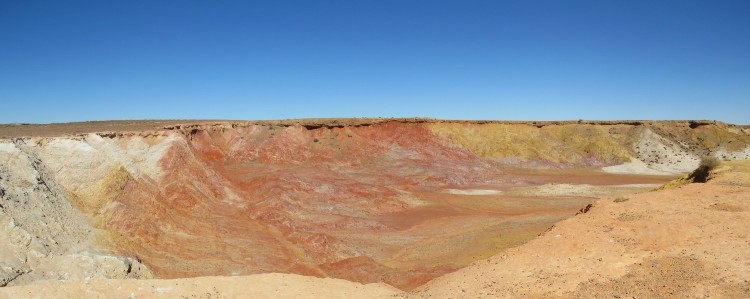
Last time we drove through Lyndhurst (in 2006), we had seen a prominent sign “Talc Alf”. We did not investigate. We later
learnt that sculptor Talc Alf, Cornelius Johan Alferink, has a workshop and gallery well worth visiting. So this time I looked
for the sign, but did not see it. Thinking perhaps he had retired and moved to a better climate, we continued south. I
still don’t know if Talc Alf is still working there or not.
They have a small caravan parking area alongside the hotel, with concrete slabs on level sites, plus power and water available. There are ladies and gents showers and toilets accessed from the exterior at the rear of the hotel. Roomy and very clean bathrooms
in this old hotel.
Hotel Manageress also allowed me to use the laundry, at no additional charge. This was
much needed after our outback touring. Powered sites were only $15, and we had an enjoyable stay in Copley.
Opposite the
hotel, the former railway siding building (at right) looked neglected.
After passing Lyndhurst, ranges of the Flinders were of both sides of the road. Towards Copley there were extensive coal mines, now all closed.
The mines closed in November 2015, with the rest of the coal still sent by rail to the Port Augusta power plants. This ceased in April 2016, with the last coal being burnt in May.
In November 2018, this tallest chimney,
which dominated the skyline around Port Augusta, was demolished with explosives. It had been one of the tallest chimneys in
Australia, standing at 200 metres, at the northern power plant. The 80 metre chimney at the southern power plant had been demolished
in 2016.
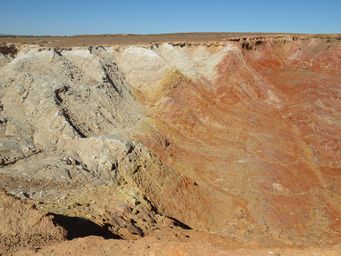
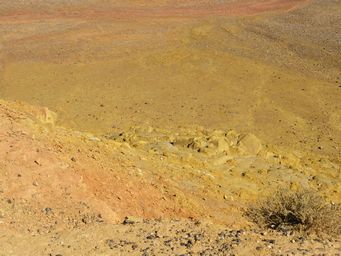
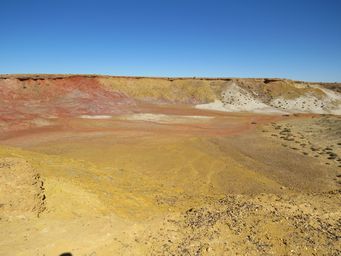
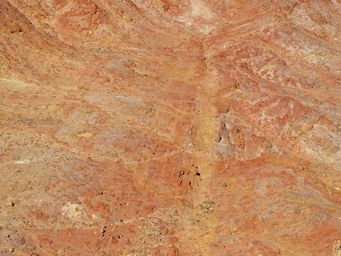
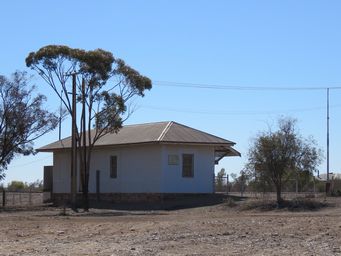
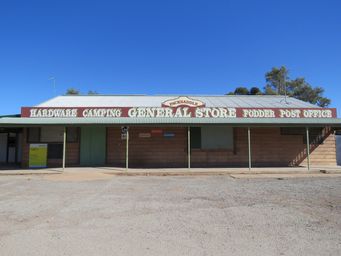
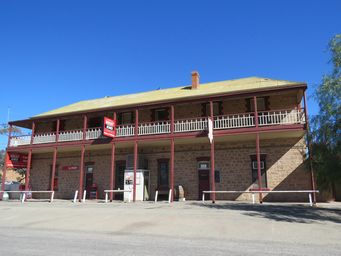
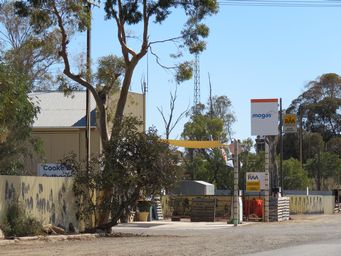
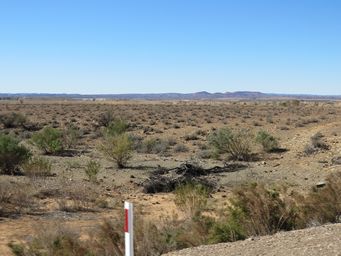
Five kilometres further south we visited Leigh Creek. This is a very neat town with school, grocery store, and post office. The town did not look as deserted as Copley, but it has suffered a big population loss. The shop was quiet, with very few customers.
An advertising board offered helicopter tours over the old coal mines “from $60 per person”.
Further south we passed former
railway siding ruins and station stone ruins by the railway near Cottage Creek.
We visited the Hotel and received a very friendly welcome from the Manageress and staff. At first I had a little difficulty finding my way into the hotel, as it is through the green door on the side of the white box. Confusing.
With the loss of the coal mine industry, around 1,000 residents were lost to the towns of Leigh Creek and Copley. Much of Copley
is for sale.